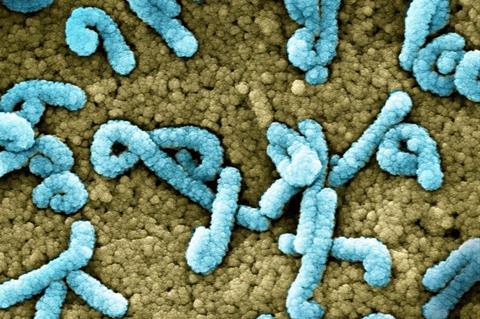Any viral infection begins with the attachment of the virus to host cells and subsequent activation of cellular receptors, making it essential to identify the factors and mechanisms involved. Therefore, COMBINE focuses on the critical virus-cell binding step, aiming to identify key factors and potential therapeutic targets involved early in viral infections.

“We will apply a combination of pioneering approaches designed to identify the signature of virus-cell activation, characterize the mechanisms of virus binding and entry, and develop novel inhibitors and vaccine candidates. Using the Marburg virus as a highly-pathogenic BSL-4 model virus, this novel approach provides a comprehensive view of the virus entry process, differentiating between initial attachment and subsequent cellular activation and internalization,” explains project coordinator Prof. Christian Sieben, leading the research group “Nano Infection Biology” at HZI. In addition to Sieben, the HZI research groups “Compound Profiling and Screening” led by Prof. Ursula Bilitewski and “Cellular Proteome Research” led by Prof. Lothar Jänsch are also involved in COMBINE.
Highly infectious and lethal
Marburg virus, like Ebola virus, is a member of the filovirus family. It is a highly infectious and lethal pathogen with substantial epidemic potential. The virus occurs in fruit bats, widely distributed across Africa, and may also be transmitted between humans. Additionally, the virus’ incubation period, ranging from two to 21 days, allows for potential silent transmission by individuals who are not yet symptomatic, further complicating outbreak control efforts.
READ MORE: A Marburg virus outbreak was confirmed in Tanzania
The recent recurrent outbreaks of the Marburg virus, including in previously unaffected countries, coupled with the lack of a licensed vaccine or specific antiviral treatment and the virus’ high lethality, underscore the ongoing threat posed by the virus as well as the significant clinical and societal interest in developing suitable antivirals.
Using the COMBINE approach, the team aims to establish the fundamental pre-clinical basis for the continued development of specific anti-MARV drugs and optimized MARV vaccines. “With COMBINE, we aim to make a lasting impact by reducing premature mortality and the healthcare burden of the Marburg virus through novel treatments and optimized vaccines. However, our work will not only strengthen the global virology community with new tools and knowledge, but also increase pandemic preparedness by addressing the health threats posed by the Marburg virus and other emerging viral diseases,” emphasizes Sieben.
Blueprint for the identification of antiviral targets
Beyond unveiling crucial insights into MARV cell entry, the project will break new ground and develop an innovative experimental pipeline for identifying and targeting proteins involved in the virus attachment process, a critical factor in combating viral outbreaks. COMBINE seeks to create a versatile, adaptable blueprint that facilitates cross-country collaborations to develop novel drugs and vaccines against emerging viruses.
The research conducted in the scope of the project will, therefore, not only expand the knowledge of the Marburg virus cell entry and therapeutic options but also establish a technology pipeline that can be rapidly applied to other emerging viruses, strengthening global health security and readiness for future pandemics.
In addition to COMBINE, the HZI is involved in another project of the Horizon Europe funding program, which is also dedicated to the search for new targets for antiviral therapies. In the project DEFENDER, coordinated at the Leibniz Institute for Virology (LIV), Prof. Mark Brönstrup, head of the department “Chemical Biology”, is investigating therapeutic concepts against emerging pathogens.
Project key facts
Title: Comparative Signature of Marburg Virus Cell Activation as a Blueprint for the Identification of Antiviral Targets against Newly Emerging Viruses (COMBINE)
Start: 1 January 2025
Duration: 60 months
Budget: 7.2 Mil €
Coordinator: Helmholtz Centre for Infection Research (HZI)
Website: combine-MARV.eu
Social Media: www.linkedin.com/showcase/combine-marv-project/about/







No comments yet